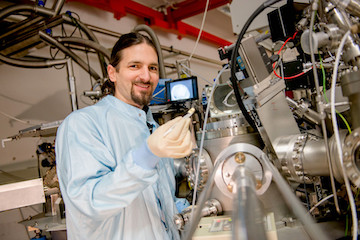Nanochip with Quantum Advantage
Physics

The Bochum researchers, here Arne Ludwig, are experts in the production of quantum dots, which can be used to realize qubits - the information units for future quantum computers.
© RUB Marquard
The technology is potentially more powerful than the world's fastest supercomputer.
A Danish-German research team has developed a tiny chip based on quantum technology that - if realized on a larger scale - could surpass the computing power of a classically operating supercomputer. The researchers showed that their nanochip can, in principle, achieve this so-called quantum advantage. Light particles, also called photons, are generated in the chip and can be used as on-the-fly quantum information units. The team from the University of Copenhagen and Ruhr University Bochum reports on the development in the journal Science Advances, published online Dec. 9, 2020.
Quantum advantage through superposition of states
Quantum computers could solve some computational tasks significantly faster than classical computers because they could process information in parallel to a high degree. While a classical computer works with bits that have either the state zero or one, quantum computers would be based on qubits that can assume many different states simultaneously. Research groups and IT companies around the world are working hard to develop a technique that would make the so-called quantum advantage a reality: a state in which a quantum technology can solve a particular computing task faster than the world's most powerful supercomputers.
The team led by Prof. Dr. Peter Lohdahl of the Copenhagen Center for Hybrid Quantum Networks has now unveiled a chip just one-hundredth as thick as a human hair that could achieve the quantum advantage. The nanochip produces stable photons into which researchers can store quantum information. The quality of the individual photons must be so high that they are quantum mechanically indistinguishable, i.e., virtually identical. If enough of these photons are generated - and this is possible with the chip - computing operations can be performed that far exceed the computing power of a classical computer.
The expertise of the Bochum group led by Dr. Arne Ludwig and Prof. Dr. Andreas Wieck from the Chair of Applied Solid State Physics, who are experts in the production of semiconductor structures that can be used to store and read out quantum information, was also crucial to the development.
Practical test requires large financial investment
The newly developed chip has not yet undergone practical testing, so the physicists have not yet used it to solve a computational problem faster than a supercomputer. Conducting such an experiment would far exceed the financial resources of a university. "Put simply, the photons produced by our chip can be compared to the switching states on transistors in classical computers, but with quantum states," says Arne Ludwig. "For the practical test, the chip would now have to be built into a photonic circuit, i.e., wired correctly, so to speak. The technology for this already exists, but a lot of work, time and money would have to be invested in its implementation."
To achieve the quantum advantage, the researchers would need to be able to use their technique to control about 50 of their qubits created in the chip. That mark comes from experiments conducted by Google, which had its quantum computer based on superconducting qubits undergo the field test. In their current work, the Danish-German team used theoretical methods to show that it would be possible to control 50 qubits using the light-based technique. Now they are looking for industry partners who could scale up the chip for practical applications.
Different types of qubits
There are different approaches to developing quantum computers, whose information units can be based on atoms, electrons or photons. Each technique has its advantages and disadvantages. According to scientists, the biggest advantage of the light-based technique is the fact that photonic technologies are already widely used in the telecommunications industry. So when scaling up the technology, it could dock onto existing infrastructure.
Quantum dots from Bochum
Over the past eight years, the Bochum team has continued to develop the manufacturing technology for quantum dots. These are structures in semiconductors that can emit qubits in the form of photons. Together with partners, they designed techniques to load and unload qubits with information in a targeted manner and to be able to transport information over long distances. Because the quantum dots are nearly perfect at emitting single photons, they are ideal for light-based applications.
Funding
This work was supported by the German Federal Ministry of Education and Research (grant numbers 16KIS0867 and Q.Link.X) and the German Research Foundation (Collaborative Research Center/Transregio 160, project number 383065199 and DFH/UFA CDFA-05-06).
Original publication
Ravitej Uppu, Freja T. Pedersen, Ying Wang, Cecilie T. Olesen, Camille Papon, Xiaoyan Zhou, Leonardo Midolo, Sven Scholz, Andreas D. Wieck, Arne Ludwig, Peter Lodahl: Scalable integrated single-photon source, in: Science Advances, 2020, DOI: 10.1126/sciadv.abc8268
Press contact
Prof. Dr. Andreas Wieck
Chair of Applied Solid State Physics
Faculty of Physics and Astronomy
Ruhr University Bochum
Phone: +49 234 32 26726
E-mail: andreas.wieck@rub.de
Dr. Arne Ludwig
Chair of Applied Solid State Physics
Faculty of Physics and Astronomy
Ruhr University Bochum
Phone: +49 234 32 25864
E-mail: arne.ludwig@rub.de
